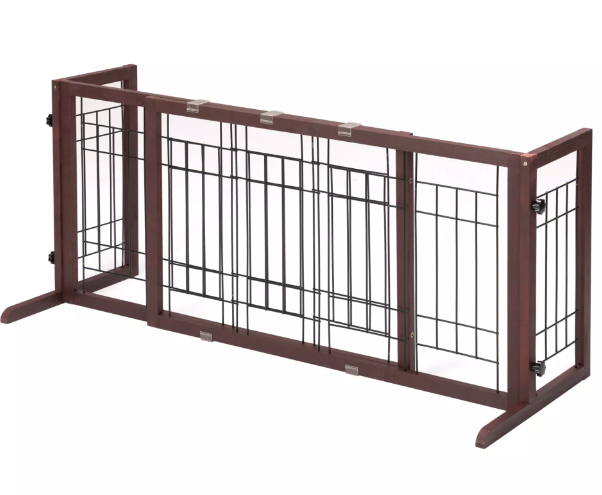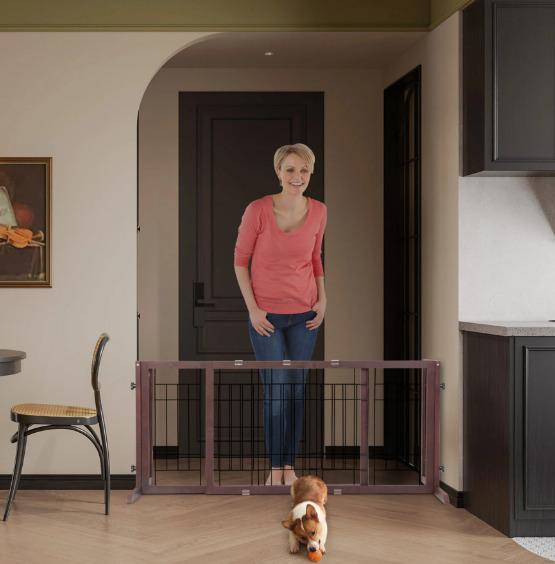For pet owners, ensuring the safety and well-being of our four-legged companions is a top priority. One essential tool in achieving this is the humble dog gate. These versatile barriers serve various purposes, from managing a dog’s movement within the house to creating designated spaces. However, a common question arises: How high should a dog gate be? In this comprehensive guide, we’ll explore the factors to consider when selecting the perfect height for a dog gate, ensuring both safety and convenience.
Tailoring to Size and Breed
Understanding Your Dog’s Size and Breed
The first and foremost consideration in determining the height of a dog gate is understanding your furry friend’s size and breed. Larger breeds, such as Great Danes or Labrador Retrievers, may require taller gates to prevent them from effortlessly leaping over. On the other hand, smaller breeds, like Dachshunds or Chihuahuas, might be adequately contained by a lower gate. Measure your dog’s height from the floor to the top of their shoulders to get a baseline idea of the gate height needed.
Installation Height vs. Actual Gate Height
When selecting a dog gate, consider both the installation height and the actual gate height. The installation height includes any space between the floor and the bottom of the gate. This is crucial for preventing smaller dogs from crawling underneath. Measure not only the height of the opening but also the height from the floor to determine the overall height required for effective containment.
Addressing Behavioral Characteristics in Dog Gate
Understanding Behavioral Patterns
In addition to physical attributes, it’s essential to consider your dog’s behavior. Some dogs are more likely to attempt to breach a barrier out of curiosity or anxiety. If your dog is prone to attempting to climb or jump over obstacles, it may be wise to choose a dog gate with added height and stability. Understanding your dog’s behavior can help you anticipate potential challenges and select a gate that addresses those specific needs.
Adjustable Height and Versatility
Flexibility is key when it comes to dog gates, especially if you have a growing puppy or multiple dogs with different needs. Look for gates with adjustable height features, allowing you to adapt the gate as your dog matures. Versatile gates that can be used in various locations, such as doorways, hallways, or at the top or bottom of stairs, provide added value and convenience.

Purpose-Driven Dog Gate Selection
Determining the Purpose of the Dog Gate
The intended purpose of the dog gate plays a significant role in deciding its height. If you’re using the gate to keep your dog out of a specific room, measure the height of the doorway to ensure the gate covers the entire opening. For restricting access to certain areas, such as stairs, opt for a gate tall enough to prevent accidental falls. When using a gate to create a confined space, such as a playpen for a puppy, choose a height that prevents them from climbing or jumping out.
Accounting for Senior Dogs
As dogs age, their physical abilities may change. Arthritis, reduced mobility, or vision impairment can affect a senior dog’s capacity to navigate obstacles. If you have an older dog, opt for dog gates that are easy to see and navigate, possibly with a built-in door or low step-over threshold. This ensures that your senior companion can move around comfortably without the risk of tripping or struggling with a gate that is too high.
Safety Features and Considerations
Safety Considerations
Puppies, in their boundless energy and curiosity, often require specific safety considerations. For small breeds or puppies, choose dog gates with smaller gaps between slats or mesh to prevent them from squeezing through. Ensure that the gate is securely installed and has a locking mechanism that can withstand the persistence of a determined pup. Additionally, avoid gates with horizontal bars that might entice climbing.
Considering Your Dog’s Agility
Dogs vary not only in size but also in agility. Some breeds are natural jumpers and climbers, while others may be less inclined to attempt such feats. If you have an athletic or energetic dog, it’s wise to choose dog gates that are higher than their standing height to account for potential leaps. Look for gates with features like vertical slats or mesh that are difficult for dogs to grip or use as footholds, deterring escape attempts.

Training and Maintenance of Dog Gate
Regular Maintenance and Inspections
Once you’ve installed the perfect dog gate, it’s crucial to conduct regular inspections to ensure its continued effectiveness. Check for any wear and tear, loose screws, or compromised components. A well-maintained gate is not only more secure but also provides peace of mind for pet owners, knowing that their pets are safely contained.
Training and Positive Reinforcement
The effectiveness of a dog gate isn’t solely dependent on its height. Training your dog to respect the boundaries set by the gate is equally crucial. Use positive reinforcement techniques to associate the gate with positive experiences, such as treats or praise when they stay within the designated area. Consistent training will not only enhance the gate’s effectiveness but also strengthen the bond between you and your furry friend.
In the quest for the perfect dog gate height, finding the right balance is key. Consider your dog’s size, breed, and agility, along with the gate’s intended purpose and installation height. Opt for adjustable gates that can grow with your puppy and provide safety features tailored to your dog’s needs. With a thoughtful approach, you can create a secure and comfortable environment for your furry friend, allowing them to thrive within the boundaries you’ve set. After all, a well-chosen dog gate not only enhances safety but also contributes to a harmonious coexistence between pets and their human companions.